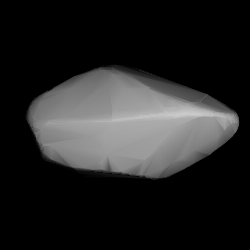
1500 Jyväskylä, provisional designation 1938 UH, is a stony Florian asteroid from the inner regions of the asteroid belt, approximately 7 kilometers in diameter. It was discovered on 16 October 1938, by Finnish astronomer Yrjö Väisälä at the Turku Observatory in Southwest Finland. It was named for the Finnish town Jyväskylä.
4349 Tibúrcio, provisional designation 1989 LX, is a dark asteroid from the central region of the asteroid belt, approximately 29 kilometers in diameter. It was discovered on 5 June 1989, by German astronomer Werner Landgraf at ESO's La Silla Observatory in northern Chile.
1014 Semphyra, provisional designation 1924 PW, is a background asteroid from the central regions of the asteroid belt, approximately 17 kilometers in diameter. It was discovered on 29 January 1924, by German astronomer Karl Reinmuth at the Heidelberg Observatory in southwest Germany. The asteroid was named after the character "Semphyra" in a poem by Aleksandr Pushkin.

1050 Meta, provisional designation 1925 RC, is a stony Eunomia asteroid from the central regions of the asteroid belt, approximately 10 kilometers in diameter. It was discovered on 14 September 1925, by German astronomer Karl Reinmuth at the Heidelberg Observatory in southwest Germany. The meaning of the asteroids's name is unknown. The presumably S-type asteroid has a rotation period of 6.14 hours and possibly an elongated shape.

1147 Stavropolis is a stony background asteroid from the inner regions of the asteroid belt. It was discovered on 11 June 1929, by Georgian–Russian astronomer Grigory Neujmin at the Simeiz Observatory on the Crimean peninsula. The S-type asteroid has a rotation period of 5.7 hours and measures approximately 14 kilometers in diameter. It was named after the Russian city of Stavropol.
1159 Granada, provisional designation 1929 RD, is a dark background asteroid and relatively slow rotator from the inner regions of the asteroid belt, approximately 30 kilometers in diameter. It was discovered on 2 September 1929, by astronomer Karl Reinmuth at the Heidelberg Observatory in southwest Germany. The asteroid was named for the Spanish city and province of Granada.
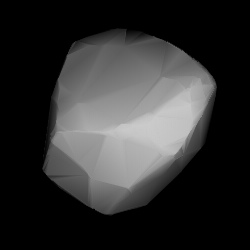
1457 Ankara, provisional designation 1937 PA, is a stony asteroid from the central region of the asteroid belt, approximately 18 kilometers in diameter. It was discovered on 3 August 1937, by German astronomer Karl Reinmuth at Heidelberg Observatory in southwest Germany, and later named for the Turkish capital city of Ankara.

1551 Argelander, provisional designation 1938 DC1, is a background asteroid from the inner regions of the asteroid belt, approximately 10 kilometers (6.2 miles) in diameter. It was discovered on 24 February 1938, by Finnish astronomer Yrjö Väisälä at the Turku Observatory in southwest Finland. The likely S-type asteroid has a rotation period of 4.1 hours. It was named after German astronomer Friedrich Argelander.
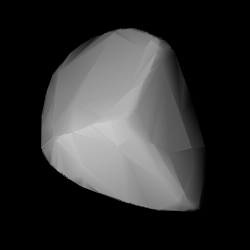
1555 Dejan, provisional designation 1941 SA, is an asteroid from the background population of the central regions of the asteroid belt, approximately 22 kilometers in diameter. It was discovered on 15 September 1941, by Belgian astronomer Fernand Rigaux at the Royal Observatory of Belgium in Uccle. The asteroid was named after Dejan Đurković, son of Serbian astronomer Petar Đurković.
1267 Geertruida, provisional designation 1930 HD, is a carbonaceous background asteroid from the inner regions of the asteroid belt, approximately 20 kilometers in diameter. Discovered by astronomer Hendrik van Gent at Johannesburg Observatory in 1930, the asteroid was later named after Geertruid Pels, sister of Dutch astronomer Gerrit Pels.

1672 Gezelle, provisional designation 1935 BD, is a carbonaceous asteroid from the outer region of the asteroid belt, approximately 27 kilometers in diameter. It was discovered on 29 January 1935, by Belgian astronomer Eugène Delporte at Royal Observatory of Belgium in Uccle, Belgium. It was later named after Flemish poet and Roman Catholic priest Guido Gezelle.
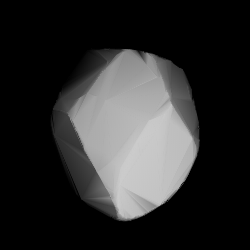
1281 Jeanne is a dark asteroid from the background population of the intermediate asteroid belt. It was discovered on 25 August 1933, by astronomer Sylvain Arend at the Royal Observatory of Belgium in Uccle, who named it after his daughter, Jeanne. The likely P-type asteroid has a rotation period of 15.2 hours and measures approximately 22 kilometers in diameter.
2173 Maresjev, provisional designation 1974 QG1, is a dark background asteroid from the outer regions of the asteroid belt, approximately 28 kilometers (17 miles) in diameter. It was discovered on 22 August 1974, by Soviet–Ukrainian astronomer Lyudmila Zhuravleva at the Crimean Astrophysical Observatory in Nauchnij, on the Crimean peninsula. It was named for Soviet war veteran Alexey Maresyev. The assumed C-type asteroid has a tentative rotation period of 11.6 hours.
2187 La Silla, provisionally designated 1976 UH, is a stony Eunomia asteroid from the middle region of the asteroid belt, approximately 12 kilometers in diameter.
2090 Mizuho, provisional designation 1978 EA, is a stony asteroid from the outer region of the asteroid belt, approximately 18 kilometers in diameter.
2043 Ortutay, provisional designation 1936 TH, is a dark asteroid from the outer regions of the asteroid belt, approximately 45 kilometers in diameter. The asteroid was discovered by Hungarian astronomer György Kulin at the Konkoly Observatory, Budapest, on 12 November 1936. It was named after Hungarian ethnographer Gyula Ortutay.
2022 West, provisional designation 1938 CK, is a stony asteroid from the middle regions of the asteroid belt, approximately 12 kilometers in diameter. It was discovered by German astronomer Karl Reinmuth at Heidelberg Observatory on 7 February 1938. The asteroid was named after Danish astronomer Richard M. West.
2058 Róka, provisional designation 1938 BH, is a Themistian asteroid from the outer regions of the asteroid belt, approximately 22 kilometers in diameter.
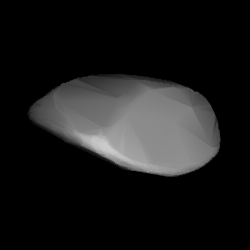
1545 Thernöe is an elongated background asteroid from the central region of the asteroid belt. It was discovered on 15 October 1941, by Finnish astronomer Liisi Oterma at Turku Observatory in Southwest Finland. The uncommon K-type asteroid has a rotation period of 16.1 hours and measures approximately 18 kilometers in diameter. It was later named after Danish astronomer Karl August Thernöe.
7526 Ohtsuka, provisional designation 1993 AA, is a stony asteroid from the inner regions of the asteroid belt, approximately 7 kilometers in diameter. It was discovered by Japanese astronomer Takeshi Urata at Nihondaira Observatory Oohira Station, Japan, on 2 January 1993. The asteroid was named after Japanese astronomer Katsuhito Ohtsuka.
